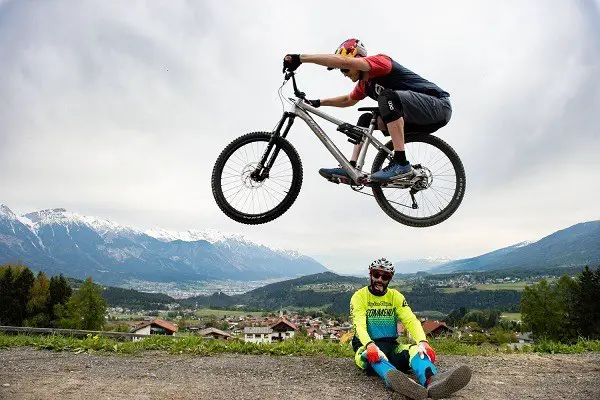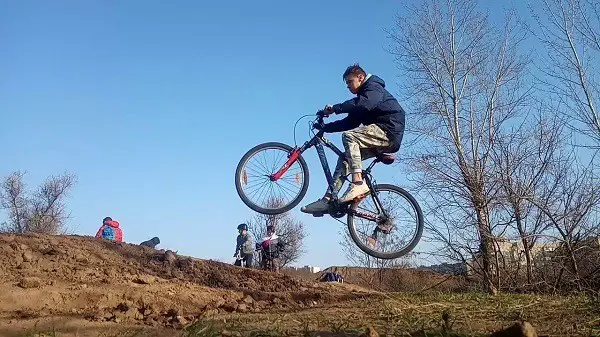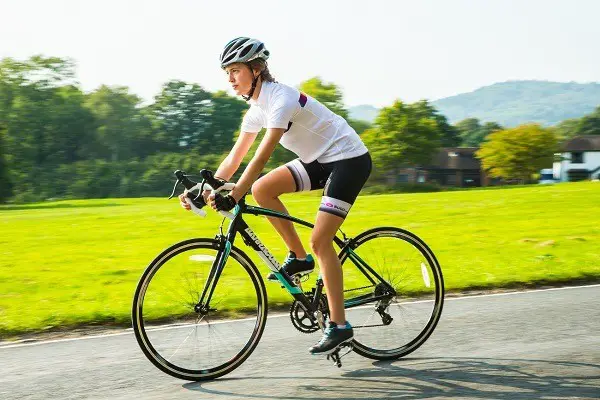Every cyclist encounters various obstacles on the road, such as a high curb, a fallen tree, potholes or bumps in the roadway. And it takes time to get around them. In addition, such obstacles can mar any trip. In order to stop looking for detours and complain about the poor work of road organizations, learn a new skill and learn how to jump on a bicycle.
Once you understand the basic principles, you will purposely look for barriers on the road to make another jump and get a small dose of adrenaline. Well, it’s time to learn how to learn to jump on a bicycle and start surprising others with spectacular jumps.
For what purposes should you use jumps
Every action has its purpose, doesn’t it? So why is it worth learning how to jump a bicycle on your own and how to apply these skills later on the road?
Situations for which it is worth learning to jump on a bicycle:
- To be able to overcome obstacles. So you don’t have to go around an uneven road, a small curb or bumps unnecessarily. This is the easiest way to jump on a bicycle, which can easily master even a beginner. With him and it is worth starting to learn how to jump.
- Jump on an object. Thanks to jumping, you can not get off the bike unnecessarily when climbing to a higher surface. For this jump, you need to learn how to jump on the bike with two wheels at once without losing your balance.
- Perform a stunt for fun. If you lack adrenaline in life, or you just like to shoot spectacular videos, then you should learn how to spectacularly jump on your bike, like a professional BMX athlete. This will add likes and comments to your social media pages. And the jump itself will attract the attention of passersby.
What kind of bikes you can do the jump on?
All current bikes can be classified into four groups:
- Urban – this type of bicycle is designed for riding on a flat paved or country road. They are durable and easy to use, have many subspecies. These models are in demand among those people who need to move around almost every day, such as gardeners, students or workers of large enterprises.
- Highway – these bikes are designed for long rides at high speeds. Their entire design is based on the athlete gaining as much speed as possible. They have a low weight and narrow wheels. Common among cycling enthusiasts. Such a bike allows you to gain the highest speed and keep it for long distances.
- Mountain – this group of bicycles is designed for riding on rough roads or rough terrain. They are versatile, as their design allows riding on both flat and dirt roads. They are heavyweight and have a sturdy frame. They are mainly chosen for walks outside the city.
- Trick bikes – this group of bikes is designed for fans of spectacular tricks.
To learn how to perform tricks and jump on your bike with two wheels, give preference to mountain and trick models. Because highway and urban with them will not cope, and jump on them you will not make.
Many people wonder if it is possible to perform maneuvers and learn to jump on a mountain bike? Such models are more focused on tackling the trail in harsh conditions rather than creating an impressive jump. Mountain bike riding involves rocky obstacles and rough road on slopes. It is on a mountain bike you can find a wide handlebar and a powerful frame. Nevertheless, such a model is perfectly suitable for learning simple elements and basic jumps. When performing them, it is necessary to take into account the large weight and overall size.
Trick bikes, as their name suggests, are designed for tricks. Jumping on them is easier than on other models. They are equipped with a sturdy frame and the handlebars are located above the seat. This creates the ideal conditions for performing acrobatic movements and great jumps that are hardly possible on other models.
Bicycle jumping techniques
At the heart of any technique is a particular type of jump. To date, there is a wide variety of options for their performance. In addition, every year professional cycling athletes add new and even more dangerous tricks to the list.
The most common techniques:
- The Bunny Hop jump is the most popular option, which allows you to jump onto any higher surface after accelerating. During the jump, two wheels come off the ground at the same time.
- Side hop is a variation of the bunny hop technique in which you can jump onto any surface from the side.
- The Roman Guy-Pad is a technique in which the weight of the body is transferred first forward and then backward. As a result, both wheels are lifted off the ground, with the front one higher. That is, the athlete occupies an upright position in the air.
- The Touch-Hop jump is a type of jump where the body weight is carried forward and the back wheel is completely lifted into the air.
- The Front Pole Jump is a technique in which the front wheel is lifted off the ground as a result of shifting the center of gravity backward.
- Tos – a combination in which several jumps on the rear wheel are performed in sequence.
- Jump Gap – a technique in which a bicycle jump is performed forward in length.
- Jump Bronco – a variation of the technique gap. The difference is that the jump is carried out to a length equal to the length of the bike.
- Jump Drop is a jump jump. Used in order to jump off an obstacle and go down. From the outside it may seem to cyclists easy movement. But by its technique is quite a difficult jump in comparison with other types.
Step by step instructions for doing the jump
To understand how to properly jump with two wheels on a bicycle, you need to start with some preliminary training. Don’t try to take a great height or perform a complicated jump right away. Start by performing simple movements on your bike on a flat surface, then you can move on to more complex ones and understand how to jump the curb and how to come down from it.
The whole scheme of performing the jump boils down to the following two actions:
- The front wheel is lifted with your hands, while pulling the handlebars toward you;
- The rear wheel is lifted with the pedals, that is, you pull the pedals up with your feet.
To practice, choose a flat piece of ground where there are no obstacles. Make sure that on your way you will not encounter debris, bottles, branches, curbs or unevenness of the roadway.
It is much easier to learn if you have contact pedals. But even without them you can learn different types of jumps and tricks. If you do not know how to use them in practice, then at first you will need time to get used to the peculiarities of their use.
A preparatory exercise
To learn how to jump on your bike and master the jumping maneuver, start with preparatory exercises separately on the rear wheel and separately on the front wheel.
Rear-wheel prep exercise:
- Firmly anchor your feet in the pedals.
- Use them to lift the rear wheel a couple of centimeters off the ground, while shifting the center of gravity forward on the handlebars.
- Gradually increase the distance between the rear wheel and the ground by 20 centimeters.
- Place a “light” obstacle, such as a branch, in your path.
- Ride your rear wheel over the obstacle.
In no case do not apply the front brakes too sharply. In the worst case scenario, you will flip over the handlebars, which can lead to serious injury and damage.
Next, as training, learn how to freely lift the front wheel off the ground. Also, at first only a couple of centimeters, gradually increasing the height of the lift. This is much easier than lifting the back wheel. Smoothly shift your body weight back and you’ll quickly master this exercise.
Lift
Before you start, get into a comfortable position so that nothing is in your way or distracting.
- Position your body weight in the center with your chest down toward the frame. Your arms and knees are slightly bent. The movement on the bicycle is in a straight line.
- Move the center of gravity back, that is, from the hands to the feet. To do this, start straightening your arms without straightening your legs. Thus, the front wheel will come off the ground and stand flush with the frame. The wheel will rise by pressing on it with straight arms. If you do it with your arms bent, it’s not a proper technique. If you get scared, use only the rear brake to slow down or stop the whole process, but not the front brake.
- When the front wheel is high off the ground, straighten your legs. Do this in a “jumping” motion, that is, straighten up sharply, as if you were doing a normal jump on the spot. In addition, push the handlebars forward and upward. In this way, the rear wheel will also be in the air.
Transfer your own weight in time
Transfer your own weight in time from your hands to your feet is a very important point. It determines the duration of the entire jump. If you shift your center of gravity too late, you’ll just end up jumping forward.
To understand at what point you need to transfer your body weight, mentally visualize the trajectory of your flight and find its middle. It is at this point begin to shift your center of gravity. This is how you achieve a great jump with maximum time in the air.
Landing
Is it possible to perform a competent landing? The main points for the correct technique to perform it:
- Relax. If you were able to get two wheels in the air, praise yourself. You have already accomplished the hardest part of the jump.
- Land on both wheels at the same time. If you land only on the rear wheel, you may inexperience lose your balance.
- Do not use your bike’s brakes when landing.
Advice
The main tips to help you learn how to perform your first bicycle jumps:
- Take your time. Consistently learn how to perform each step of the jump, and don’t try to do a complicated acrobatic stunt right away without prior preparation. As in any endeavor, bicycle jumps need measuredness.
- A little speed. Start performing your first tricks at 10-15 kilometers per hour and no more. In the beginning, learn how to perform the jump at a low speed and only after successful attempts move on to higher speeds.
- Contact pedals. They differ in a special way of grip of the foot and the pedal itself. Such products combine the cyclist’s shoes with the pedal mechanism in a single design. With their help, it is easier to develop the maximum speed on the bike and easier to learn how to perform jumps.
- Use protection. Riding bicycles is accompanied by falls, especially when first trying to learn how to jump. Take care of your health and use protective equipment to prevent possible injuries. Wear a helmet, heavy gloves, and knee pads.
- Do not fall for the “weak”. Perform the movements for yourself, not for the audience. To do this, do not try to cover all the difficult tricks at once. Otherwise, the jump can lead to injuries.
Conclusion
Mastering the technique of performing jumps is quite a useful skill that will come in handy for any cyclist on the road. It takes time, patience, and desire to understand how to do it and learn how to jump on a mountain bike or stunt bike. If you have these resources, you can easily learn new spectacular moves and easily make your first jump. Remember that skill and professionalism come with experience after many hours of practice.
Never forget that you can fall off the bike at any time and get injured. It is not a safe sport. So use protection at least during training to avoid unpleasant consequences and to avoid getting hurt.










